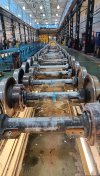I see that the Piccadilly Line is going through its annual leaf falls tribulations. Could anyone with knowledge let me know:
How many trains are out of service?
When things are likely to get back to normal (is it just a case of re-profiling the wheels or are there deeper issues)?
Any thought of an emergency timetable - maybe a bit late now but it would have been a useful contigency plan?
Will there be any 2024 stock in service next year for the leaf fall season next year? (I've heard late next year mentioned.) Hopefully the 24 stock will have better wheel slide protection - I understand thst S stock is far better at coping with the problem between Rayners Lane & Uxbridge than 73 stock.
How many trains are out of service?
When things are likely to get back to normal (is it just a case of re-profiling the wheels or are there deeper issues)?
Any thought of an emergency timetable - maybe a bit late now but it would have been a useful contigency plan?
Will there be any 2024 stock in service next year for the leaf fall season next year? (I've heard late next year mentioned.) Hopefully the 24 stock will have better wheel slide protection - I understand thst S stock is far better at coping with the problem between Rayners Lane & Uxbridge than 73 stock.

